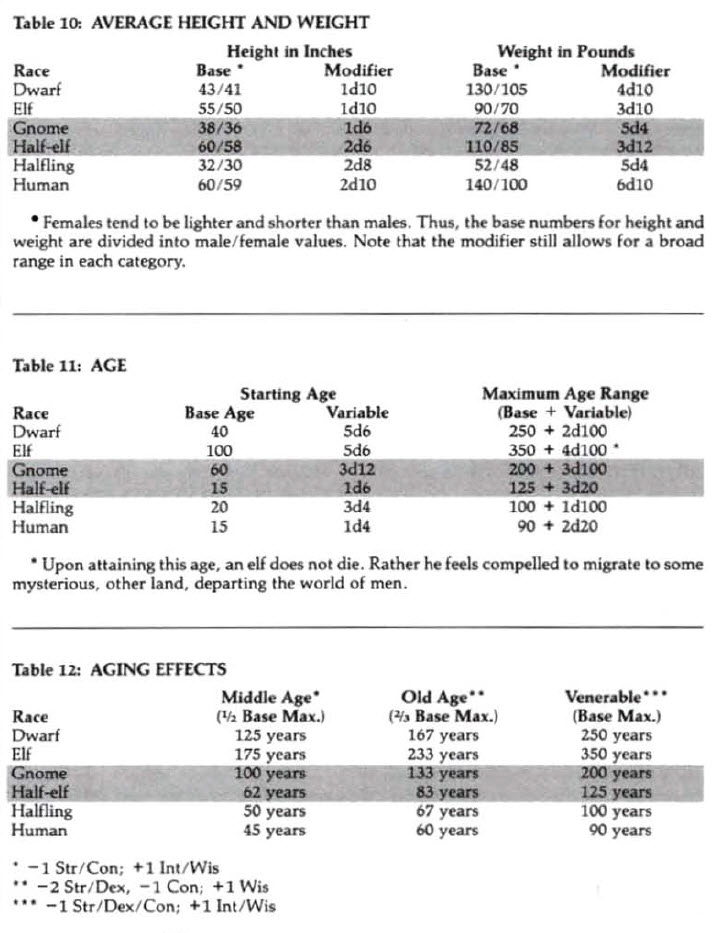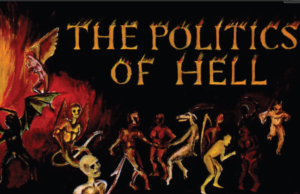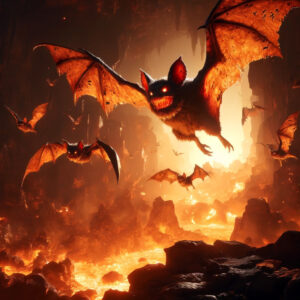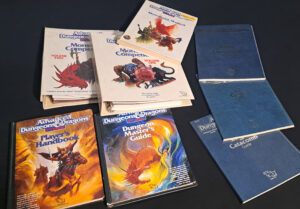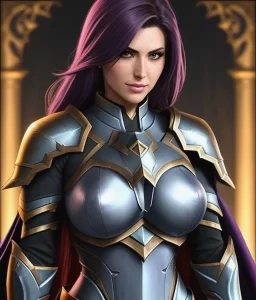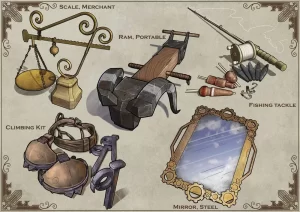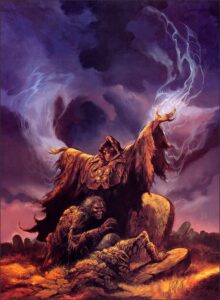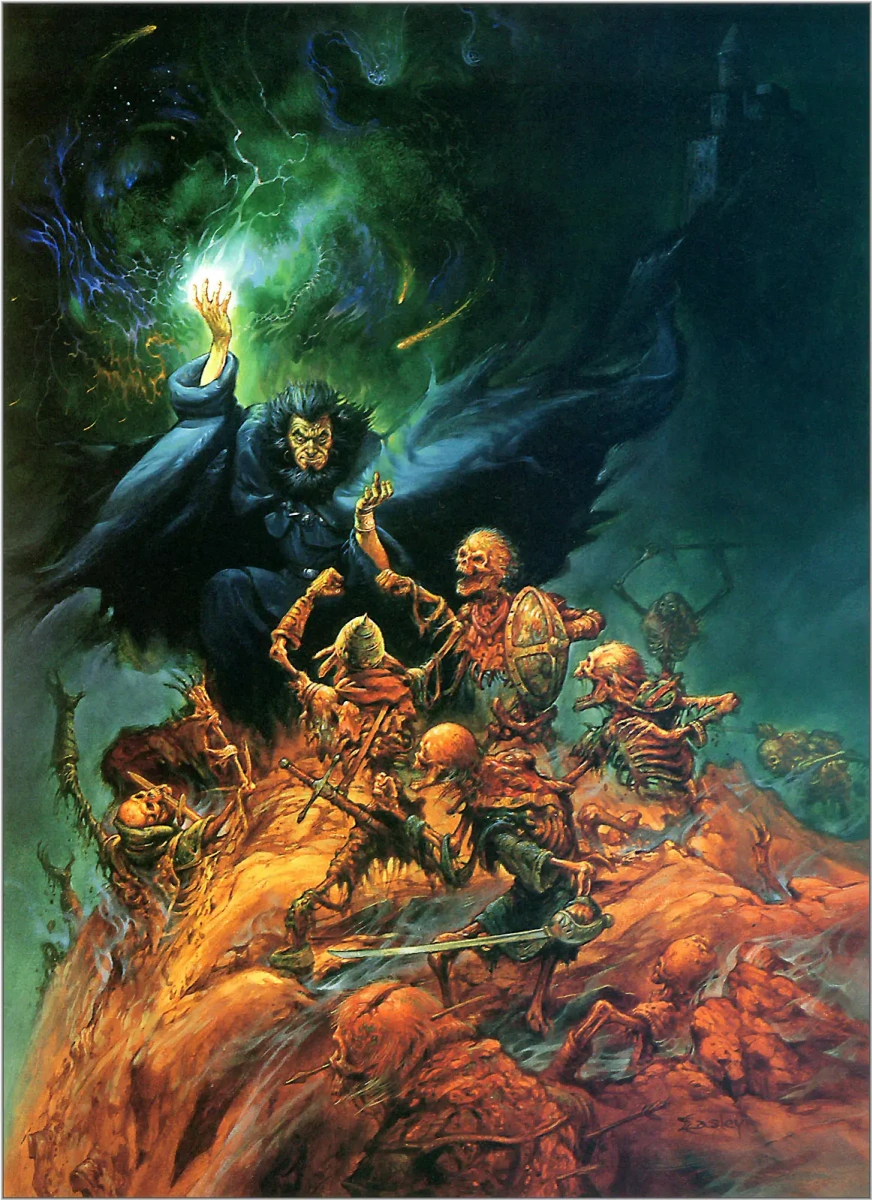
After creating your character's ability scores, you must select a player character race. This is not a race in the true sense of the word: caucasian, black, asian, etc. It is actually a fantasy species for your character -- human, elf, dwarf, gnome, half-elf, or halfling. Each race is different. Each possesses special powers and has different lists of classes to choose from.
All six of the standard races are described in detail in this chapter. In many cases, broad statements are made concerning the race in general. Players are not bound by these generalities. For example, the statement that "dwarves tend to be dour and taciturn" does not mean that your character cannot be a jolly dwarf. It means that the garden-variety dwarf is dour and taciturn. If player characters were just like everyone else, they wouldn't be adventurers. Make your character unique and he will be more fun to play.
Minimum and Maximum Ability Scores
All nonhuman PC races (also called "demihuman" races) have minimum and maximum requirements for their ability scores. If you want to have a demihuman character, the character's ability scores must be within the allowable range. The minimums and maximums for each race are listed on Table 7 (the minimums are listed before the slash; the maximums are listed after the slash). Your character's sex has no effect on these minimums or maximums.
Consult Table 7 before making any racial adjustments to your character's ability scores. If the basic scores that you rolled up meet the requirements for a particular race, your character can be of that race, even if later modifications change the ability scores so they exceed the maximums or don't meet the minimums. Once you satisfy the requirements at the start, you never have to worry about them again.
Table 7 gives the minimum and maximum scores a newly created character must have to be a member of a demihuman race. Any character can be a human, if the player so desires.
Table 7:
Racial Ability Requirements

Racial Ability Adjustments
If you chose to make your character a dwarf, elf, gnome, or halfling, you now have to adjust some of your character's ability scores. The adjustments are mandatory; all characters of these races receive the adjustments. Even if adjustments raise or lower your character's ability scores beyond the minimums and maximums shown on Table 7, you do not have to pick a new race. The adjustments can also raise a score to 19 or lower it to 2.
Table 8:
Racial Ability Adjustments
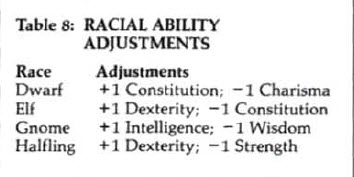
Class Restrictions and Level Limits
The human race has one special ability in the AD&D game: Humans can choose to be of any class-- warrior, wizard, priest, or rogue -- and can rise to great level in any class. The other races have fewer choices of character classes and usually are limited in the level they can attain. These restrictions reflect the natural tendencies of the races (dwarves like war and fighting and dislike magic, etc.). The limits are high enough so a demihuman can achieve power and importance in at least one class. A halfling, for example, can become the best thief in the land, but he cannot become a great fighter.
The limits also exist for play balance. The ability of humans to assume any role and reach any level is their only advantage. The demihuman races have other powers that make them entertaining to play -- particularly the ability to be multi-classed (see Glossary). These powers balance the enjoyment of play against the ability to rise in level. Ask your DM for the level limits imposed on nonhuman characters.
Languages
Racial languages for demihumans can be handled in either of two ways, depending on whether or not your DM uses the optional proficiency system. Either way, your character automatically knows his native language.
Without the proficiency system, your character starts adventuring already knowing a number of additional languages (the number depends on his Int score, see Table 4). The additional languages must be chosen from among those listed in his race's description.
If you use the proficiency system, your character receives additional languages by using proficiency slots (see Chapter 5: Proficiencies) to determine how many languages he knows when he starts adventuring (his native language does not cost a slot). Demihumans must choose these languages from among those listed in the following racial descriptions.
Human PCs generally start the game knowing only their regional language--the language they grew up speaking. The DM may decide to allow beginning PCs additional languages (up to their Int score limit or proficiency slot limit), if he feels the PCs had the opportunity to learn these as they grew up. Otherwise, human PCs may learn additional languages as they adventure.
Dwarves
Dwarves are short, stocky fellows, easily identified by their size and shape. They average 4 to 4-½ feet tall. They have ruddy cheeks, dark eyes, and dark hair. Dwarves generally live for 350 years.
Dwarves tend to be dour and taciturn. They are given to hard work and care little for most humor. They are strong and brave. They enjoy beer, ale, mead, and even stronger drink. Their chief love, however, is precious metal, particularly gold. They prize gems, of course, especially diamonds and opaque gems (except pearls, which they do not like). Dwarves like the earth and dislike the sea. Not overly fond of elves, they have a fierce hatred of orcs and goblins. Their short, stocky builds make them ill-suited for riding horses or other large mounts (although ponies present no difficulty), so they tend to be a trifle dubious and wary of these creatures. They are ill-disposed toward magic and have little talent for it, but revel in fighting, warcraft, and scientific arts such as engineering.
Though dwarves are suspicious and avaricious, their courage and tenacity more than compensate for these shortcomings.
Dwarves typically dwell in hilly or mountainous regions. They prefer life in the comforting gloom and solidness that is found underground. They have several special abilities that relate to their underground life, and they are noted for being particularly resistant to magics and poisons.
A character of the dwarven race can be a cleric, a fighter, or a thief. He can also choose to be a fighter/cleric or fighter/thief.
From living underground, dwarves have found it useful to learn the languages of several of their neighbors, both friendly and hostile. The initial languages a dwarf can learn are common, dwarf, gnome, goblin, kobold, orc, and any others your DM allows. The actual number of languages is limited by the Intelligence of the player character (see Table 4) or by the proficiency slots he allots to languages (if that optional system is used).
By nature, dwarves are nonmagical and never use magical spells (priest spells are allowed however). This gives a bonus to dwarves' saving throws against attacks from magical wands, staves, rods, and spells. This bonus is +1 for every 3 - ½ points of Constitution score. Thus, for example, if a dwarf has a Constitution score of 7 he gains +2 on saving throws. These bonuses are summarized on Table 9.
Table 9:
Constitution Saving Throw Bonuses
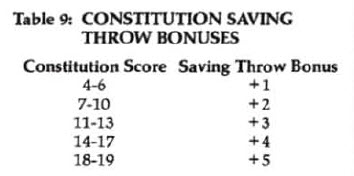
Similarly, dwarves have exceptional resistance to toxic substances. All dwarven characters make saving throws against poison with the same bonuses that they get against magical attacks (see Table 9).
Also because of their nonmagical nature, however, dwarves have trouble using magical items. All magical items that are not specifically suited to the character's class have a 20% chance to malfunction when used by a dwarf. This check is made each time a dwarf uses a magical item. A malfunction affects only the current use; the item may work properly next time. For devices that are continually in operation, the check is made the first time the device is used during an encounter. If the check is passed, the device functions normally until it is turned off. Thus, a dwarf would have to check upon donning a robe of blending but would not check again until he had taken the robe off and then put it on again. If a cursed item malfunctions, the character recognizes its cursed nature and can dispose of the item. Malfunction applies to rods, staves, wands, rings, amulets, potions, horns, jewels, and all other magical items except weapons, shields, armor, gauntlets, and girdles. This penalty does not apply to dwarven clerics using priest items.
In melee, dwarves add 1 to their dice rolls to hit orcs, half-orcs, goblins, and hobgoblins. When ogres, trolls, ogre magi, giants, or titans attack dwarves, these monsters must subtract 4 from their attack rolls because of the dwarves' small size and combat ability against these much bigger creatures.
Dwarven infravision enables them to see up to 60 feet in the dark.
Dwarves are miners of great skill. While underground, they can detect the following information when within 10 feet of the particular phenomenon (but they can determine their approximate depth below the surface at any time).
Detect grade or slope in passage 1-5 on 1d6
Detect new tunnel/passage construction 1-5 on 1d6
Detect sliding/shifting walls or rooms 1-4 on 1d6
Detect stonework traps, pits, and deadfalls 1-3 on 1d6
Determine approximate depth underground 1-3 on 1d6
Note that the dwarf must deliberately try to make these determinations; the information does not simply spring to mind unbidden.
Because of their sturdy builds, dwarves add 1 to their initial Constitution scores. Their dour and suspicious natures cause them to subtract 1 from their initial Charisma scores.
Elves
Elves tend to be somewhat shorter and slimmer than normal humans. Their features are finely chiseled and delicate, and they speak in melodic tones. Although they appear fragile and weak, as a race they are quick and strong. Elves often live to be over 1,200 years old, although long before this time they feel compelled to depart the realms of men and mortals. Where they go is uncertain, but it is an undeniable urge of their race.
Elves are often considered frivolous and aloof. In fact, they are not, although humans often find their personalities impossible to fathom. They concern themselves with natural beauty, dancing and frolicking, playing and singing, unless necessity dictates otherwise. They are not fond of ships or mines, but enjoy growing things and gazing at the open sky. Even though elves tend toward haughtiness and arrogance at times, they regard their friends and associates as equals. They do not make friends easily, but a friend (or enemy) is never forgotten. They prefer to distance themselves from humans, have little love for dwarves, and hate the evil denizens of the woods.
Their humor is clever, as are their songs and poetry. Elves are brave but never foolhardy. They eat sparingly; they drink mead and wine, but seldom to excess. While they find well-wrought jewelry a pleasure to behold, they are not overly interested in money or gain. They find magic and swordplay (or any refined combat art) fascinating. If they have a weakness it lies in these interests.
There are five branches of the elven race; aquatic, gray, high, wood, and dark. Elf player characters are always assumed to be of the most common type -- high elves -- although a character can be another type of elf with the DM's permission (but the choice grants no additional powers). To the eye of outsiders, the differences between the groups are mostly cosmetic, but most elves maintain that there are important cultural differences between the various groups. Aquatic elves spend their lives beneath the waves and have adapted to these conditions. Gray elves are considered the most noble and serious-minded of this breed. High elves are the most common. Wood elves are considered to be wild, temperamental, and savage. All others hold that the subterranean dark elves are corrupt and evil, no longer part of the elven community.
A player character elf can be a cleric, fighter, wizard, thief, or ranger. In addition, an elf can choose to be a multi-class fighter/mage, fighter/thief, or ranger. In addition, an elf can choose to be a multi-class fighter/mage, fighter/thief, fighter/mage/thief, or mage/thief. (The rules governing these combinations are explained under "Multi-Class and Dual-Class Characters" in Chapter 3: Player Character Classes).
Elves have found it useful to learn the languages of several of the forest's children, both the good and the bad. As initial languages, an elf can choose common, elf, gnome, halfling, goblin, hobgoblin, orc, and gnoll. The number of languages an elf can learn is limited by his Intelligence (see Table 4) or the proficiency slots he allots to languages (if that optional system is used).
Elven characters have 90% resistance to sleep and all charm-related spells. (See Chapter 9: Combat for an explanation of magic resistance.) This is in addition to the normal saving throw allowed against a charm spell.
When employing a bow of any sort other than a crossbow, or when using a short or long sword, elves gain a bonus of +1 to their attack rolls.
An elf can gain a bonus to surprise opponents, but only if the elf is not in metal armor. Even then, the elf must either be alone, or with a party comprised only of elves or halflings (also not in metal armor), or 90 feet or more away from his party (the group of characters he is with) to gain this bonus. If he fulfills these conditions, he moves so silently that opponents suffer a -4 penalty to their surprise die rolls. If the elf must open a door or screen to attack, this penalty is reduced to -2.
Elven infravision enables them to see up to 60 feet in darkness.
Secret doors (those constructed so as to be hard to notice) and concealed doors (those hidden from sight by screens, curtains, or the like) are difficult to hide from elves. Merely passing within 10 feet of a concealed door gives an elven character a one-in-six chance (roll a 1 on 1d6) to notice it. If actively searching for such doors, elven characters have a one-in-three chance (roll a 1 or 2 on 1d6) to find a secret door and a one-in-two chance (roll a 1, 2, or 3 on 1d6) to discover a concealed portal.
As stated previously, elven characters add 1 to their initial Dexterity scores. Likewise, as elves are not as sturdy as humans, they deduct 1 from their initial Constitution scores.
Gnomes
Kin to dwarves, gnomes are noticeably smaller than their distant cousins. Gnomes, as they proudly maintain, are also less rotund than dwarves. Their noses, however, are significantly larger. Most gnomes have dark tan or brown skin and white hair. A typical gnome lives for 350 years.
Gnomes have lively and sly senses of humor, especially for practical jokes. They have a great love of living things and finely wrought items, particularly gems and jewelry. Gnomes love all sorts of precious stones and are masters of gem polishing and cutting.
Gnomes prefer to live in areas of rolling, rocky hills, well wooded and uninhabited by humans. Their diminutive stature has made them suspicious of the larger races--humans and elves--although they are not hostile. They are sly and furtive with those they do not know or trust, and somewhat reserved even under the best of circumstances. Dwelling in mines and burrows, they are sympathetic to dwarves, but find their cousins' aversion to surface dwellers foolish.
A gnome character can elect to be a fighter, a thief, a cleric, or an illusionist. A gnome can have two classes, but not three: fighter/thief, illusionist/thief, etc.
Due to his upbringing, a beginning gnome character can choose to know the following languages, in addition to any others allowed by the DM: common, dwarf, gnome, halfling, goblin, kobold, and the simple common speech of burrowing mammals (moles, badgers, weasels, shrews, ground squirrels, etc.). The actual number of languages a character begins with depends upon his Intelligence score (see Table 4) or the proficiency slots he allots to languages (if that optional system is used).
Like their cousins the dwarves, gnomes are highly magic resistant. A gnome player character gains a bonus of +1 for every 3½ points of Constitution score, just as dwarves do (see Table 9). This bonus applies to saving throws against magical wands, staves, rods, and spells.
Gnomes also suffer a 20% chance for failure every time they use any magical item except weapons, armor, shields, illusionist items, and (if the character is a thief) items that duplicate thieving abilities. This check is made each time the gnome attempts to use the device, or, in the case of continuous-use devices, each time the device is activated. Like dwarves, gnomes can sense a cursed item if the device fails to function.
In melee, gnome characters add 1 to their attack rolls to hit kobolds or goblins. When gnolls, bugbears, ogres, trolls, ogre magi, giants, or titans attack gnomes, these monsters must subtract 4 from their attack rolls because of the gnomes' small size and their combat skills against these much larger creatures.
Gnomish infravision enables them to see up to 60 feet in the dark.
Being tunnelers of exceptional merit, gnomes are able to detect the following within 10 feet (exception: They can determine their approximate depth or direction underground at any time.). They must stop and concentrate for one round to use any of these abilities.
Detect grade or slope in passage 1-5 on 1d6
Detect unsafe walls, ceiling, and floors 1-7 on 1d10
Determine approximate depth underground 1-4 on 1d6
Determine approximate direction underground 1-3 on 1d6
Gnome characters gain a +1 bonus to their Intelligence scores, to reflect their highly inquisitive natures. They suffer a -1 penalty to Wisdom because their curiosity often leads them unknowingly into danger.
Half-Elves
Half-elves are the most common mixed-race beings. The relationship between elf, human, and half-elf is defined as follows: 1) Anyone with both elven and human ancestors is either a human or a half-elf (elves have only elven ancestors). 2) If there are more human ancestors than elven, the person is human; if there are equal numbers or more elves, the person is half-elven.
Half-elves are usually much like their elven parent in appearance. They are handsome folk, with the good features of each of their races. They mingle freely with either race, being only slightly taller than the average elf (5 feet 6 inches on average) and weighing about 150 pounds. They typically live about 160 years. They do not have all the abilities of the elf, nor do they have the flexibility of unlimited level advancement of the human. Finally, in some of the less-civilized nations, half-elves are viewed with suspicion and superstition.
In general, a half-elf has the curiosity, inventiveness, and ambition of his human ancestors and the refined senses, love of nature, and artistic tastes of his elven ancestors.
Half-elves do not form communities among themselves; rather, they can be found living in both elven and human communities. The reactions of humans and elves to half-elves ranges from intrigued fascination to outright bigotry.
Of all the demihuman races, half-elves have the greatest range of choices in character class. They tend to make good druids and rangers. A half-elf can choose to be a cleric, druid, fighter, ranger, mage, specialist wizard, thief, or bard. In addition, a half-elf can choose from the following multi-class combinations: cleric (or druid)/fighter, cleric (or druid)/fighter/mage, cleric (or druid)/ranger, cleric (or druid)/mage, fighter/mage, fighter/thief, fighter/mage/thief, and mage/thief. The half-elf must abide by the rules for multi-class characters.
Half-elves do not have a language of their own. Their extensive contact with other races enables them to choose any of the following languages (plus any other allowed by the DM): common, elf, gnome, halfling, goblin, hobgoblin, orc, and gnoll. The actual number of languages the character knows is limited by his Intelligence (see Table 4) or by the number of proficiency slots he allots to languages (if that optional system is used).
Half-elven characters have a 30% resistance to sleep and all charm-related spells.
Half-elven infravision enables them to see up to 60 feet in darkness.
Secret or concealed doors are difficult to hide from half-elves, just as they are from elves. Merely passing within 10 feet of a concealed door (one hidden by obstructing curtains, etc.) gives the half-elven character a one-in-six chance (roll a 1 on 1d6) of spotting it. If the character is actively seeking to discover hidden doors, he has a one-in-three chance (roll a 1 or 2 on 1d6) of spotting a secret door (one constructed to be undetectable) and a one-in-two chance (roll a 1, 2, or 3 on 1d6) of locating a concealed door.
Halflings
Halflings are short, generally plump people, very much like small humans. Their faces are round and broad and often quite florid. Their hair is typically curly and the tops of their feet are covered with coarse hair. They prefer not to wear shoes whenever possible. Their typical life expectancy is approximately 150 years.
Halflings are sturdy and industrious, generally quiet and peaceful. Overall they prefer the comforts of home to dangerous adventuring. They enjoy good living, rough humor, and homespun stories. In fact, they can be a trifle boring at times. Halflings are not forward, but they are observant and conversational if in friendly company. Halflings see wealth only as a means of gaining creature comforts, which they love. Though they are not overly brave or ambitious, they are generally honest and hard working when there is need.
Halfling homes are well-furnished burrows, although most of their work is done on the surface. Elves generally like them in a patronizing sort of way. Dwarves cheerfully tolerate them, thinking halflings somewhat soft and harmless. Gnomes, although they drink more and eat less, like halflings best, feeling them kindred spirits. Because halflings are more open and outgoing than any of these other three, they get along with other races far better.
There are three types of halflings: Hairfeets, Tallfellows, and Stouts. Hairfeets are the most common type, but for player characters, any of the three is acceptable.
A halfling character can choose to be a cleric, fighter, thief, or a multi-class fighter/thief. The halfling must use the rules provided for multi-class characters.
Through their contact with other races, halfling characters are allowed to choose initial languages from common, halfling, dwarf, elf, gnome, goblin, and orc, in addition to any other languages the DM allows. The actual number of languages the character knows is limited by his Intelligence (see Table 4) or by the number of proficiency slots he allots to languages (if that optional system is used).
All halfling characters have a high resistance to magical spells, so for every 3-½ points of Constitution score, the character gains a +1 bonus on saving throws vs. wands, staves, rods, and spells. These bonuses are summarized on Table 9.
Halflings have a similar resistance to poisons of all sorts, so they gain a Constitution bonus identical to that for saving throws vs. magical attacks when they make saving throws vs. poison (i.e., +1 to +5, depending on Constitution score).
Halflings have a natural talent with slings and thrown weapons. Rock pitching is a favorite sport of many a halfling child. All halflings gain a +1 bonus to their attack rolls when using thrown weapons and slings.
A halfling can gain a bonus to surprise opponents, but only if the halfling is not in metal armor. Even then, the halfling must either be alone, or with a party comprised only of halflings or elves, or 90 feet or more away from his party to gain this bonus. If he fulfills any of these conditions, he causes a -4 penalty to opponents' surprise rolls. If a door or other screen must be opened, this penalty is reduced to -2.
Depending on their lineage, certain halfling characters have infravision. Any halfling character has a 15% chance to have normal infravision (this means he is pure Stout), out to 60 feet; failing that chance, there is a 25% chance that he has limited infravision (mixed Stout/Tallfellow or Stout/Hairfeets lineage), effective out to 30 feet.
Similarly, halflings with any Stoutish blood can note if a passage is an up or down grade with 75% accuracy (roll a 1, 2, or 3 on 1d4). They can determine direction half the time (roll a 1, 2, or 3 on 1d6). These abilities function only when the character is concentrating on the desired information to the exclusion of all else, and only if the character is pure or partially Stout.
Halfling characters have a penalty of -1 to their initially generated Strength scores, and they gain a bonus of +1 to Dexterity.
Humans
Although humans are treated as a single race in the AD&D game, they come in all the varieties we know on Earth. A human PC can have whatever racial characteristics the DM allows.
Humans have only one special ability: They can be of any character class and rise to any level in any class. Other PC races have limited choices in these areas.
Humans are also more social and tolerant than most other races, accepting the company of elves, dwarves, and the like with noticeably less complaint.
Because of these abilities and tendencies, humans have become significant powers within the world and often rule empires that other races (because of their racial tendencies) would find difficult to manage.
Other Characteristics
After you have selected a race, you may want to fill in the details of your character. You are not required to do so, but there are many situations in which this information is vital or useful to role-playing.
The sex and name of your character are up to you. Your character can be of the same sex as yourself or of the opposite sex.
Some people feel it is important to know whether their character is right- or left-handed. Actually, this has no bearing on the play of the game, since all characters are assumed to be reasonably competent with either hand (that doesn't mean everyone is trained to fight with two weapons). It is easiest to say that your character has the same handedness as you. This will result in the normal ratio of right- to left-handed people.
On occasion it may be useful to know your character's height and weight. The best way to determine height and weight is to choose the appropriate numbers, subject to your DM's approval. If you want a short, pudgy human fighter, you can select an appropriate height and weight. Otherwise, heights and weights can be generated randomly using Table 10. Take the appropriate base score and add the dire roll modifier. As with all tables, this can create some ridiculous results (one of the problems with randomness) and, at the same time, cannot account for the full variety of mankind (or demihumankind). The table only reproduces a fairly average range for each race. Heights and weights for demihuman races not listed on the table must be decided by your DM.
The tallest man on record stood 8 feet 11.1 inches, while the tallest woman was 8 feet 1.25 inches. The shortest man was only 26.5 inches tall and the shortest woman bettered this at only 24 inches in height. While the lightest humans are also among the shortest, the heaviest man weighed an estimated 1,400 pounds and stood only 6 feet 1 inch. The heaviest woman is thought to have weighed 880 pounds. Obviously, these figures indicate that there is a great deal of variety possible for player characters.
Players may also want to know their characters' starting ages. Human characters can start at any age that is agreeable to both the player and the DM. However, all beginning adventurers are assumed to be at least 16 years old, since they must grow physically, emotionally, and in practical experience before they are ready to undertake the rigors of an adventuring life. Table 11 can be used to give a starting age (add the variable die roll to the base starting age to get the character's starting age) and the possible life span of a character, assuming a quiet and peaceful life. Humans are also included on this list in case you want to determine their ages randomly. The maximum age for a character should be secretly determined and recorded by the DM. Player characters may have an idea of how long they expect to live, but do not know their true allotted life span.
As a character ages, his ability scores are affected. Upon reaching one-half of his base maximum age (45 for a human), the character loses 1 point of Strength (or half of his exceptional Strength rating) and 1 point of Constitution, but gains 1 point each of Intelligence and Wisdom. At two-thirds of his base maximum age (60 for a human), the character loses 2 more points of Strength (or all his exceptional Strength and 1 point more), 2 points of Dexterity, and 1 more point of Constitution, but he gains 1 point of Wisdom. Upon reaching the base maximum age, the character loses 1 more point from each of Strength, Dexterity, and Constitution, while gaining 1 more point in both Intelligence and Wisdom. All aging adjustments are cumulative. See Table 12 for a summary of these effects.
Although many people have claimed to live to great ages, the oldest human of verifiable age was 113 years old in 1988 and is still alive!
There may be times when a magical device or spell adds years to or subtracts years from a player character's life. This magical aging can have two different effects. Some magical aging physically affects the character. For example, a haste spell ages those it affects by one year. This aging is added directly to the player character's current age. He physically acquires the appearance of himself one year older (a few more wrinkles, etc.). Characters who increase in age from magical effects do not gain the benefits of increased Wisdom and Intelligence--these are a function of the passage of game time--but the character does suffer the physical losses to Strength, Dexterity, and Constitution associated with aging. These are breakdowns of the body's systems. Physical age can also be removed in the same manner. Some potions give years back to the character. In this case, the physical appearance of the character is restored. The character can regain lost vigor (Str, Dex, and Con) as his body is renewed but he does not lose any of the benefits of aging (Wis and Int).
Magical aging can also work to increase or decrease the life span of the character. In such a case, the actual age of hte character is unaffected. All adjustments are made by the DM to the character's maximum age (which only the DM knows). For example, a human finds a magical fountain that bestows great longevity (10 to 60 years more). The DM has already determined the human will naturally live to 103 years (base 90 + 2d20, in this case 13). The water of the fountain bestows 40 more years so that, unless the character meets a violent end, he will live to 143 years. He still suffers the effects of aging at the usual ages (45, 60, and 90 years, respectively), but the period in which he would be considered a venerable elder of his people is extended for 40 years.
There are a number of other personal characteristics your character has--hair and eye color, body shape, voice, noticeable features, and general personality. There are no tables for these things, nor should there be. Your job, as a player, is to add these details, thereby creating the type of character you want. You probably know some from the start (do you want to play a towering, robust warrior, or a slim, unassuming swordsman?); others, especially your character's personality, will grow and take form as you play. Remember, you are an actor and your character is your role!
Table 10, 11 and 12: Height, Weight, Age and Aging
